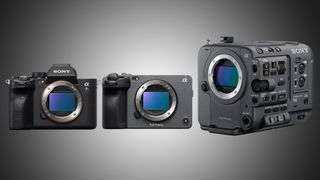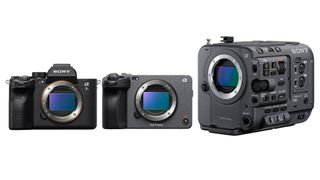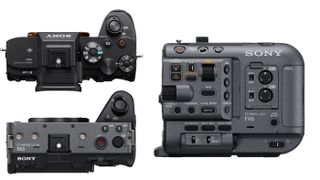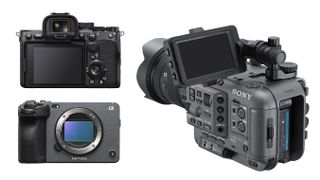Sony A7S III vs Sony FX3 vs Sony FX6: how do you choose which one to buy?
When Sony announced the A7S III we thought it was amazing, but then came the FX6 and now the FX3 – how do you choose?

We are here to get Sony out of a fix. In the space of just a few months, it’s launched three powerful video cameras, all with a full frame 12MP sensor, all capable of shooting 4K at up to 120p and all aimed at a middle price point in the rapidly expanding professional video/cinema market.
They share a lot of basic technology in common, and they can’t all be the best, so we’re going to unravel the differences, some of which are quite subtle, to help you decide which is the best Sony 4K video camera for you – the Sony A7S III, the new Sony FX3 or the Sony FX6.
1. Sensor

• Sony A7S III: Full frame back-illuminated EXMOR R CMOS, 10.2/12MP
• Sony FX3: Full frame back-illuminated EXMOR R CMOS, 10.2/12MP
• Sony FX6: Full frame back-illuminated EXMOR R CMOS, 10.2MP
OK, well, so all three cameras have the same sensor. They also share the same Sony BIONZ XR processor. All three have 10.2MP available for video, but where the A7S III and FX3 can also shoot 12MP stills, the FX6 is solely set up for video.
2. ISO range
• Sony A7S III: ISO 80-409,600 (expanded)
• Sony FX3: ISO 80-409,600 (expanded)
• Sony FX6: ISO 320-409,600 (expanded), base ISO 800/12,800
All three cameras have the same maximum ISO in expanded mode, but the FX6 has a higher base ISO. All three use dual native ISO technology, so there's little to choose between them in this respect.
3. Color
• Sony A7S III: S-Log 3/2, HLG
• Sony FX3: S-Cinetone, S-Log 3/2, HLG
• Sony FX6: S-Cinetone, S-Log 3/2, HLG, custom LUTs
There’s a steady progression of capabilities here. The Sony A7S III offers Sony S-Log modes and HLG, but the FX3 adds in the S-Cinetone mode used throughout Sony’s Cinema Line cameras. The FX6 goes a step further, offering all these options plus the ability to use custom LUTs.
4. Resolution
• Sony A7S III: Full frame QFHD (4K UHD), Super35 FHD
• Sony FX3: Full frame QFHD (4K UHD), Super35 FHD
• Sony FX6: Full frame QFHD (4K UHD), Super35 FHD
There are no differences here. All three cameras can only offer 4K capture with the full frame sensor area. If you want to use Super35 (maybe you have Super35 or APS-C lenses) you’re stuck with full HD resolution.

5. Frame rates
• Sony A7S III: 4K 120p, FHD 240p
• Sony FX3: 4K 120p, FHD 240p
• Sony FX6: 4K 120p, FHD 240p
Again, there’s no difference here. All three cameras use the same sensor and the same processor to produce the same maximum frame rates for 4K and full HD video – though they don’t all offer the same recording times, and the the Sony FX6 records 4K/120p in S&Q mode only without audio.
6. Cooling
• Sony A7S III: Passive
• Sony FX3: Internal fan
• Sony FX6: Internal fan
Here’s a significant difference: The Sony A7S III is pretty good at managing heat build up, but its passive cooling and heat dissipation system has its limits and can’t match the performance of the fan-equipped FX3 and FX6, which offer unlimited recording times in most modes.
7. ND filters
• Sony A7S III: No
• Sony FX3: No
• Sony FX6: Built in 1/4-1/128
Here’s an important difference. ND filters are important to videographers who want to adjust to different light levels without changing the iris setting and hence the ‘look’, and without juggling ISO settings. Neither the A7S III nor the FX3 has ND filters built in, but the FX6 does.
8. Stabilization
• Sony A7S III: 5-axis IBIS
• Sony FX3: 5-axis IBIS
• Sony FX6: No
Here’s another important difference, and this time not in the FX6’s favor. The A7S and FX3 both have the in-body stabilization familiar from the Sony Alpha line; the FX6 does not have in-body stabilization. Presumably Sony does not expect this camera to be used handheld.
9. Design

• Sony A7S III: Mirrorless camera
• Sony FX3: Mirrorless camera with handle
• Sony FX6: Box camera with handle
This will be a matter of personal preference, but while the A7S III is designed as a hybrid camera for both stills and video, the FX3 takes the same basic shape but adapts it heavily for video, including accessory mounting points and a carry handle with XLR mic input. The FX6 follows a classic box-style cinema camera design.
10. Size and weight
• Sony A7S III: 128.9x96.0x69.7mm, 614g (body only)
• Sony FX3: 129.7x77.8x84.5mm, 715g (body only)
• Sony FX6: 114x116x153mm, 890g
The Sony A7S III is the smallest and lightest of the three, but while the FX3 is a fraction bigger and heavier, Sony claims (rightly) that it’s by far the smallest camera in its Cinema line, which is where it sees it in the Sony range (not in the Alpha line). The FX6 is a good deal larger, though not a whole lot heavier.
Conclusion

The Sony A7S III is a good choice if you are looking for a good hybrid stills/video camera, though its modest 12MP resolution does significantly undermine its appeal for stills. This suggests to use that the FX3 is a much more attractive proposition. It’s much better adapted to video, especially physically, and doesn’t cost a lot more. It’s still not quite the full cinema package, though, in the way that the FX6 is. The FX6 lacks in-body stabilisation, but it has the form factor, the connections and controls that cinematographers will eventually gravitate towards.
Read more:
• Best camera for filmmaking
• Best camera for video
• Best cinema cameras
• Best Sony cameras
• Best cameras for vlogging
• Sony A7S III review
• Sony FX6 review
Get the Digital Camera World Newsletter
The best camera deals, reviews, product advice, and unmissable photography news, direct to your inbox!

Rod is an independent photography journalist and editor, and a long-standing Digital Camera World contributor, having previously worked as DCW's Group Reviews editor. Before that he has been technique editor on N-Photo, Head of Testing for the photography division and Camera Channel editor on TechRadar, as well as contributing to many other publications. He has been writing about photography technique, photo editing and digital cameras since they first appeared, and before that began his career writing about film photography. He has used and reviewed practically every interchangeable lens camera launched in the past 20 years, from entry-level DSLRs to medium format cameras, together with lenses, tripods, gimbals, light meters, camera bags and more. Rod has his own camera gear blog at fotovolo.com but also writes about photo-editing applications and techniques at lifeafterphotoshop.com